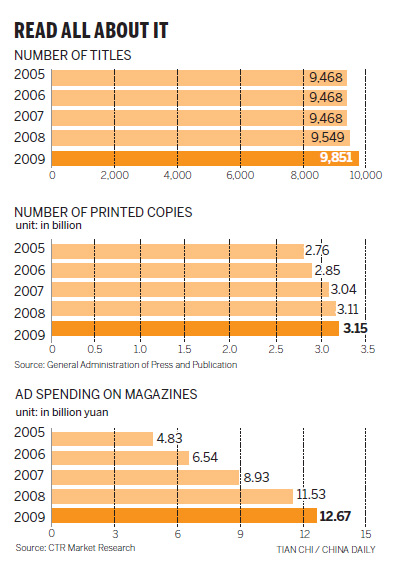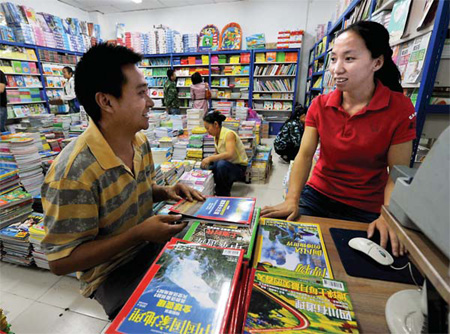Focus
Magazines turning new page in battle for readers
By Jiang Xueqing (China Daily)
Updated: 2010-09-01 12:16
 |
Large Medium Small |

Imaginative design, relevant articles help periodicals thrive in digital age. Jiang Xueqing reports in Beijing.
As global media moguls were slashing budgets and jobs last year, Zhu Xuedong, editor-in-chief of China Weekly, chose a different path and re-launched the magazine in a dynamic new format.
It was a bold move that bucked the international trend but the 43-year-old was more than confident that a "dignified, thoughtful and valuable" current affairs magazine would turn a profit.

Compared to saturated markets in Britain and the United States, Zhu said his research showed the print media market in China had a great deal of potential, thanks largely to an increase in readership and a growing desire among the public for in-depth, analytical news coverage.
"Chinese readers are thirsty for human values and that's exactly what magazines sell," he said. "You can always find magazines that target certain groups of people, talking about their life, beliefs and interests."

Spending on advertising with national magazines in the US alone fell 19.3 percent last year, according to preliminary figures released by the Nielsen Company, a global marketing research firm. Last month, the Washington Post Company sold Newsweek for $1, with the 77-year-old publication reportedly suffering operating losses of $44 million since 2007.
Yet, despite print media worldwide facing serious challenges from the Internet and devices like Apple's iPad, magazines have experienced rapid growth in recent years in China and many experts agree with Zhu that the print media is holding strong with a large proportion of China's 1.3 billion people.
Among the most popular magazines, Sanlian Lifeweek has seen distribution and advertising increase 15 to 20 percent every year since 2005, while Chinese National Geography (circulation 800,000) has maintained an annual growth of 30 to 40 percent.
An independent audit by BPA Worldwide also found that Vista, a news digest published every 10 days, sold 650,000 copies per issue in the first half of this year, up from 490,000 in the second half of 2009.
Industry analysts say the boom is closely linked to the economic development that began in 2003, which boosted public demand and enabled readers to afford magazines, which are more expensive than newspapers.
Magazines also remain popular with advertisers. China's gross advertising spending hit 277 billion yuan ($40 billion) in the first half of this year, with about 7.1 billion yuan of that going to magazines, an increase of 21 percent year-on-year, according to Beijing-based CTR Market Research.
"Compared to television and newspapers, magazines started late in China and have always had a relatively small market share," said Daphne Wu Chuanhui, managing director of Caixin Media, which publishes Century Weekly, a national news magazine.

A decade ago, if someone said they worked for a business magazine "no one would have any idea what they were talking about", she said. "But the fact that the market share is tied to GDP growth and consumer power means the industry has a bright future."
Better with age
Victor Visot, chief executive of Hachette Filipacchi Medias Asia Pacific, a global consumer magazine publishing group, is also optimistic and said that, like a fine wine, China's magazine market needs to mature.
"The Chinese market is rather new compared to other parts of the world," he said. "But it's growing because it is sustained by the overall growth of the economy."
Chen Zhong, editor-in-chief of Nanfengchuang, agreed that the decade-old market for news magazines is on a lifting track and is still far from reaching a saturation point.
"Take news magazines for example. You could count on both hands almost every popular title in the country," he said.
A total of 9,851 registered magazine titles published more than 3 billion copies in 2009, generating a combined operating revenue of 14.6 billion yuan ($2.1 billion), according to figures from the General Administration of Press and Publication (GAPP).
However, the statistics, which show the number of printed copies soared from just 558 million in 1978 to 2.5 billion in 1985, suggest the industry experienced a plateau for the last 25 years.
Shi Feng, chairman of the China Periodicals Association and former deputy director of the GAPP, blamed the problem on a "bottleneck" in the administration.
In recent years, applications for standard serial numbers were rarely approved by the GAPP, which licensed just 383 new titles between 2006 and 2009.
Of all the titles registered today, said Shi, just 1,000 are magazines that can be found at newsstands and in bookstores. The rest is mainly research periodicals, academic journals and brochures produced by government departments.
"There is a bottleneck and until it is solved many other problems will remain," he said.
Even if a magazine has stopped running, owners refuse to cancel their registration and some transfer or rent serial numbers for huge sums of money, which is against the regulations.
"Magazines should keep flowing, with new titles coming out and old ones dying off," said Shi. "Without an elimination system (to reclaim unused serial numbers), this pool of running water has turned stagnant."
Electronic revolution
In terms of consumption capacity and reading habits, analysts say new media is yet to have a major impact on the well-educated middle-class that has begun to form in China's cities, allowing magazines to build up and maintain loyal readerships.
"As an emerging market economy, China is lagging behind the US," said Zhu. "We're following in its footsteps but at a slower rhythm.
"With the surge in mobile and wireless devices, the Chinese magazine market still has room for growth in a foreseeable future, although that room is relatively limited compared to five years ago," he added.
However, Li Hongping, executive publisher of Vista, who is developing an electronic edition of the magazine that will be available on the iPhone, predicts the impact of new media on the industry will be huge.
"All editors will need to figure out what to do in three to five years," he said.
Yet, others within the industry insist new technology does not have to be the death knell to traditional practices. Among them is Visot at Hachette Filipacchi who said print and digital media should complement each other, not be in competition.
"China has a long history of printing," he said. "Except maybe in some parts of the market, I don't believe China will give up on print publications."
Although Wu, the Caixin Media chief, also sees new media as an opportunity for editors to share their magazines' stories and pictures with different channels, she warned the real challenge will come with the integration.
The mindsets and skills of those in the print and digital media are different, she said, so executives will need to explore effective ways to build teams that not only produce first-class content but also capable of presenting it to readers through various multi-media platforms.
|
 Zhai Huizhen, right, owner of a bookstore in Urumqi, capital of the Xinjiang Uygur autonomous region, sells magazines in her newly opened store. The print media market in China has great potential, say analysts, despite the challenges posed by new media. Jin Wei / for China Daily |
In that sense, as long as the stories are of high quality, new media will have little impact other than to boost the channels available.
"It's the same with traditional industrial products," said Li Shuanke, publisher and editor-in-chief of Chinese National Geography. "With leading technologies, companies are not afraid of copycats because they've already walked the frontier and dug out the largest chunks of gold, leaving only a few nuggets for those following behind."
Optimistic or pessimistic, publishers are now looking into how to integrate their print and new media divisions.
Century Weekly has introduced an iPhone application and is now adapting it for the iPad.
Sanlian Lifeweek will unveil its profit model in the fourth quarter, according to chief editor Zhu Wei, who added that the magazine is also designing a special online community for high-end readers.
"The print media will be polarized in the future and the high-end media organizations that survive the crisis will diversify their communication approaches," said Zhu.
Revenue streams could be a problem. As the Internet is seen as a free resource, netizens have high demands of those companies that attempt to charge for news services. Research shows, however, that online advertising and mobile Internet charges are feasible, according to a study by Caixin Media.
"Traditional media will always face challenges, with new media forever standing up to confront old ones," said Li Hongping at Vista. "But the life and death of a media depends on whether it grasps the opportunity to develop at the turning point.
"Dramatic changes might happen right there," he added.